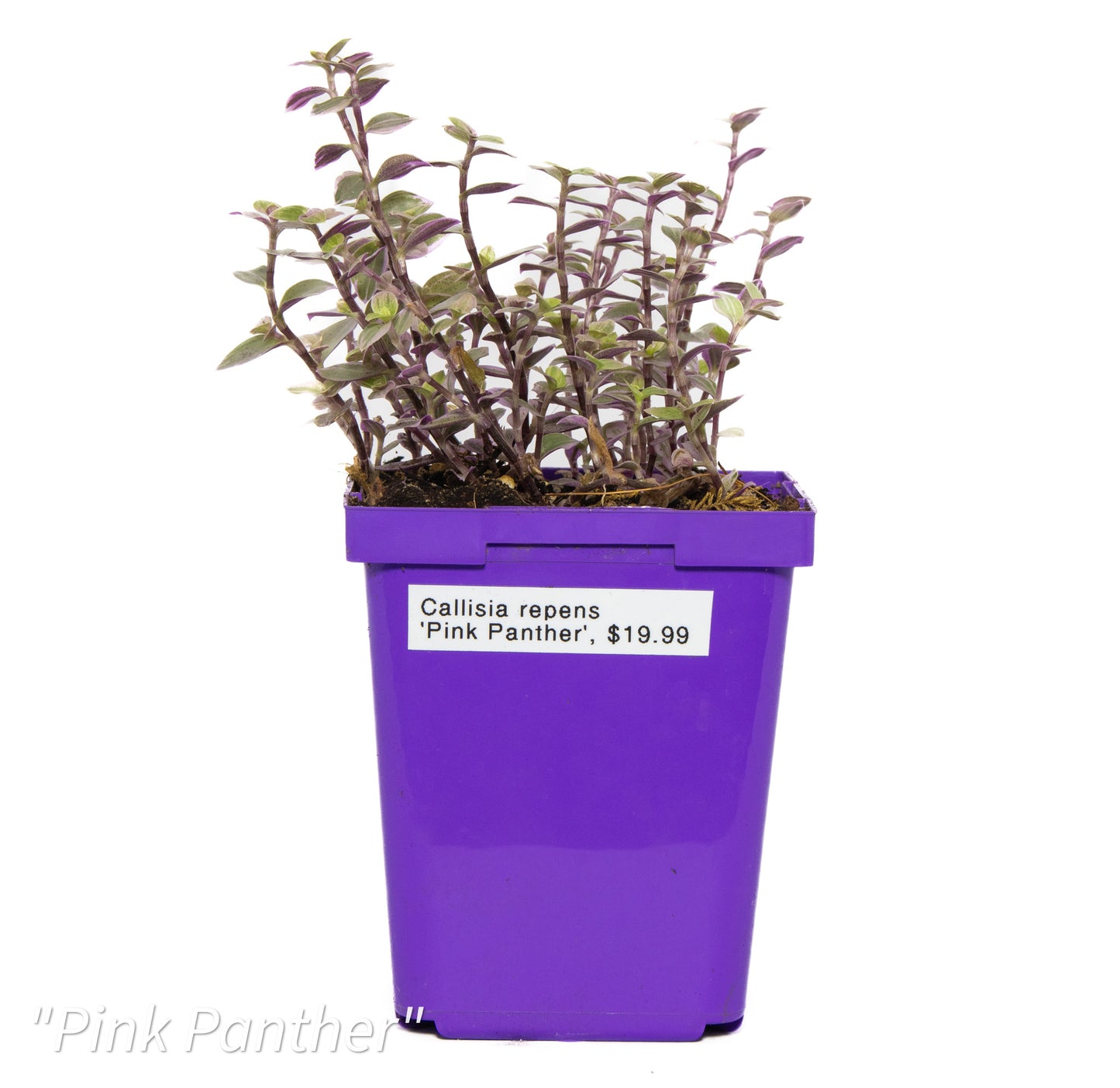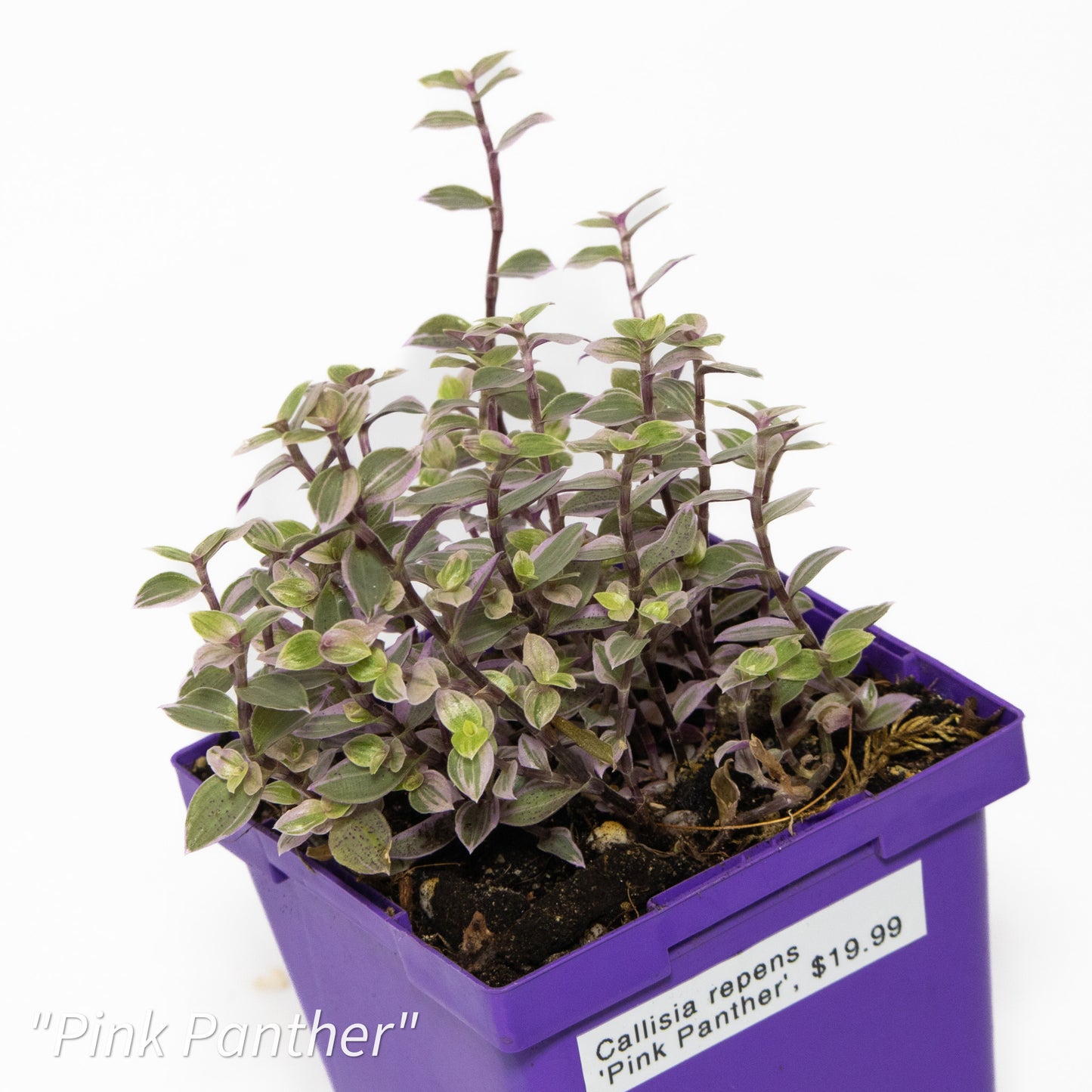Royal Python's Cove
Callisia repents ‘Pink Panther’
Callisia repents ‘Pink Panther’
Couldn't load pickup availability
Callisia repens ‘Pink Panther’, also known as Pink Panther or Pink Turtle Vine, is a stunning, low-growing trailing plant prized for its vibrant pink, purple, and green variegated foliage. This hardy, fast-growing plant is an excellent choice for bioactive setups, where it will enhance the natural ecosystem of your terrarium, vivarium, or paludarium.
Care Instructions
LIGHT. Prefers bright, indirect light to maintain its vivid pink hues. While it can tolerate lower light levels, the colors will be more intense in brighter conditions. In bioactive setups, position it near a light source, but avoid prolonged direct sunlight, which may cause leaf burn.
SOIL. Thrives in a well-draining, loose soil mix. A blend of coconut coir, perlite, and orchid bark mimics its natural environment, ensuring good aeration. In bioactive enclosures, this type of substrate promotes root health while providing an ideal habitat for isopods and springtails, which help break down organic matter.
WATERING. Keep the soil lightly moist but not waterlogged. Allow the top ½ to 1 inch of soil to dry between waterings to prevent root rot. In bioactive setups, decomposers like isopods and springtails will help balance moisture levels by breaking down organic material.
HUMIDITY. Thrives in moderate to high humidity levels, making it an excellent fit for humid bioactive environments. 60%+ humidity encourages lush growth and helps maintain its vibrant colors. If the air is too dry, occasional misting will benefit the plant.
TEMPERATURE. Prefers warm temperatures between 65°F and 80°F (18°C to 27°C). Avoid placing it near cold drafts or excessive heat sources, as extreme fluctuations can stress the plant.
FERTILIZATION. During the growing season (spring and summer), feed with a balanced liquid fertilizer every 4-6 weeks to encourage growth and maintain its vibrant colors. Reduce feeding in winter when growth slows. For a natural, organic boost, try using Mealworm Frass, a nutrient-rich fertilizer that supports healthy foliage.
Cohabitation with Bioactive Organisms
ISOPODS. Isopods complement Pink Panther by aerating the soil and breaking down organic debris, preventing substrate compaction. They will consume fallen leaves, contributing to a natural cycle of decomposition and enrichment.
SPRINGTAILS. These beneficial micro-organisms help manage mold, fungi, and excess moisture, keeping the soil fresh and preventing root rot. Their presence ensures a balanced micro-ecosystem that supports the plant’s long-term health.
Soil and Maintenance Tips
SUBSTRATE. Use a well-draining, nutrient-rich mix, such as coconut coir, perlite, and orchid bark, to promote root health and support decomposers. Adding a thin layer of activated charcoal at the bottom of the enclosure can improve filtration and odor control.
HUMIDITY CONTROL. A shallow water dish or occasional misting can help maintain the ideal humidity levels in a bioactive setup. The presence of springtails will assist in moisture management, preventing mold and decay.
TRIMMING. Callisia repens ‘Pink Panther’ is a fast grower. Regular trimming encourages bushy, compact growth and prevents leggy stems. Cuttings can be easily propagated in water or soil, making this plant ideal for expanding your collection.
PEST CONTROL. Naturally resistant to most pests, but in a bioactive environment, springtails and isopods will help prevent infestations by consuming pest eggs and larvae. Occasionally check for signs of spider mites or aphids, especially in drier conditions.
With its stunning pink foliage, easy care, and fast growth, Callisia repens ‘Pink Panther’ is an ideal plant for bioactive terrariums. It thrives alongside isopods and springtails, creating a sustainable, nutrient-rich ecosystem. By providing bright indirect light, proper humidity, and a well-draining substrate, you’ll ensure healthy growth and a flourishing environment.
Share




